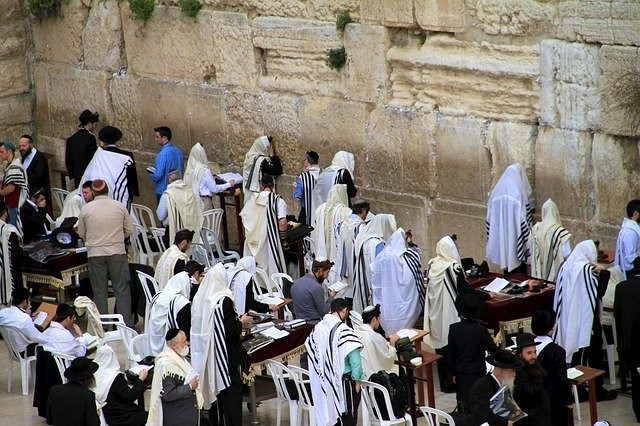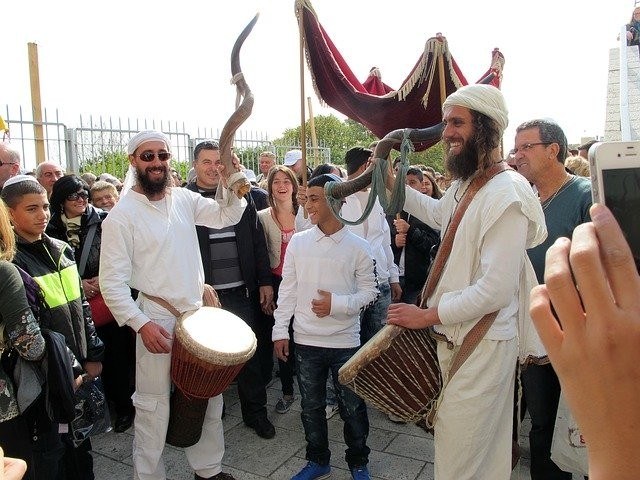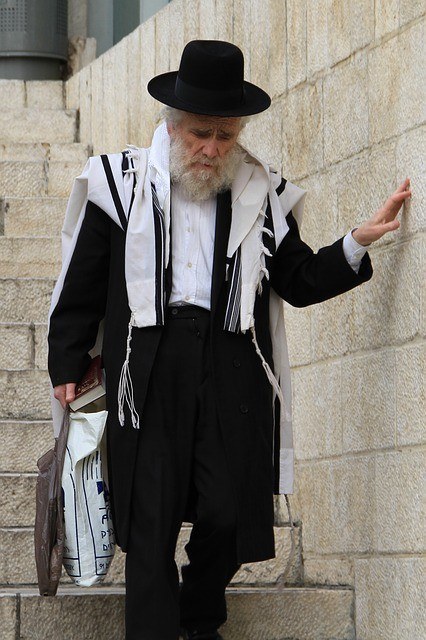
In Judaism, practices and rituals enrich a millenary culture. Through following its customs, those of the Jewish faith and culture can continue carrying on customs that have been practiced for generations. This helps to establish a connection with our ancestors, blending the rituals of today with those of the past and reminding the Jewish people of the importance of traditions, even with modern twists.
Judaism: Practices and Rituals – Pregnancy
One of the highest held beliefs in Judaism is the importance of reproduction. Focusing on the first commandment of man by God, there is a strong belief that it is important to “be fruitful, and multiply” (Genesis 1:28).
During pregnancy and after birth, some believe that mothers will endure a period of unclean blood and impurity. If a mother gives birth to a boy, her blood may be considered unclean for nearly a week, and then she would be considered impure for around a month. To wear the effects of this, the mothers may perform sin- and burnt-offerings at the end of these periods.
Many of the preconceived notions behind the rituals of births in the Jewish community are brought on from surrounding cultural communities, not so much of the religious aspects themselves. For example, stones, herbs, charms, talismans could be used to aid the birthing process. Even chalk could be used as a defensive barrier against invading evil spirits, and all house doors were kept open.
[If you want to better understand Judaism, practices, and rituals specific to the Jewish religion, knowing the Hebrew language might be a priceless asset. You can read here my article on this topic.]
The Celebration of Births
In more present times, nightly vigil ceremonies are held to celebrate the birth of children, particularly male births, and to do prayers that ward off evil spirits. With regard to a male baby, the firstborn is often considered a crucial status, called primogeniture. This status enables them to receive special treatment in terms of inheritance and other cultural customs.
While male babies were often a priority in terms of Judaism practices and rituals, the Jewish Feminist movement has modernized ceremonies and celebrations of female births as well.
Establishing a bond between people and God is essential in Judaism, so a covenant called a berit in Hebrew will be formed shortly after the births.
One of the ceremonies that most male babies receive is the rite of circumcision, also called the brit millah. Still continued to this day, this is an ancient practice that has been continued in Judaism through generations. It is believed that God had instructed Abraham to have this ritual, of the removal of an eight-day-old infant’s foreskin, passed down as a way to keep a covenant between them and God.
While this is still a highly debated topic in Judaism, it has garnered support from physicians in the medical benefits that this removal can serve, especially in terms of sanitation.

Alternatively, females receive a naming ceremony at their synagogues as a way to create this bond. This naming typically will occur during the father’s first time attending the synagogue after her birth. After parts of the Old Testament are read, the father is praised and gifted candies. Over time, there have been different customs added to these ceremonies, and less conservative groups may even have the ceremony held at the parents’ home.
Coming of Age
There are two Jewish coming of age ceremonies; one is called the Bar Mitzvah, which translates to “son of the commandment,” while the other is Bat Mitzvah, or “daughter of the commandment.”
Males are considered an adult at 13 years old, while it is 12 for females. Not all communities encouraged Bat Mitzvahs, although they have become almost as equally popular today as Bar Mitzvahs. This adulthood then recognizes that they are of the proper age to carry out their obligations to the commandments and may be of service and value to religious ceremonies.
This recognition is considered automatically, as these ceremonies are not required but continue as a cultural practice.
It originally involved the celebrated reciting a blessing for the weekly reading of the Torah. However, it has evolved today to the point that these new adults are required to learn, read, and recite an entire section of the Torah called the haftarah, meaning “conclusion.” They are no longer simple ceremonies, but very complicated and anticipated.
Places of Worship
The place of worship in Judaism is often referred to as synagogue or temple. However, “temple” is not necessarily a term that many Jews use themselves, preferring the former. “The Temple” is, instead, used to address a specific one that was ruined by Babylonians then Romans in Jerusalem.
Synagogues aren’t always built with the same style. Rather, they reflect the culture of the surrounding area, as some synagogues are built more like churches in the West.
Commonly among all is that it is rarer to have images displayed of people or animals. They usually have three items: an Aron Kodesh ( an ark to hold Torah scrolls), a Ner Tamid (a light burned above the arc), and a bimah (a raised platform).
Worshiping Rituals
The usual daily services are broken down into three parts: Ma’ariv (evening), Shacharit (morning), and Minchah (afternoon). Synagogue religious services are performed through minyans or a kind of quorum composed of adults.
Morning prayers are often designated for home and are incorporated with the morning routine. These blessings are said while standing up, and the first may involve washing the hands to symbolize the cleansing of any impurities. The following blessings then thank God and bless the Torah, as one of the commandments of Jewish people is to study the Torah on a daily basis.
On the opposite end of the spectrum is nightly blessings, said before nighttime and sleeping. These blessings are used to conjure peace, comfort, and protection.
Jews may also do prayers for Sabbath (Shabbat), which occurs on Saturday. It is the seventh day of the week and is guided by God’s command of rest from work. Celebrating this day involves a candle lighting ceremony and dining, with a Kabbalat Shabbat prayer in between.
The Treatment of Food
Like in other cultures, it is common in Judaism to do a prayer before eating, referred to as brachot or benedictions. They all begin with the same way (“Blessed are you God, our Lord, King of the World”), and only differ at the end with the food mentioned. For those who do this ritual, they may follow other rules pertaining to this, like only saying this when they physically see their prepared food and not eating or drinking while it is done.
Depending on the community, some groups do follow Jewish dietary laws called kashrut. These laws may involve not eating certain types of items from animals or not eat meat and dairy products that are mixed into one meal. Most Israeli Jews keep with this custom, with nearly 60% keeping kosher in their homes.
Kosher has become a popular enough word that it is used in the English language, although it has a different meaning in Judaism. It actually refers to not only Jewish foods but anything that the food may touch, like aluminum foil. These containers are usually checked to see if they are made with products and ingredients that may violate kashrut.
Love and Marriage Customs
Some followers of Judaism believe in finding love with a “soul mate.” This match is called bashert in Yiddish, which translates to “fated.” Before marriage, it is considered nearly impossible to know for sure who someone’s particular match is, and this is only clarified through marriage.
A marriage may be fulfilled in three ways: money (which could be symbolized as a ring), a contract, and sexual intercourse. However, if the woman does not consent to the marriage, it is considered invalid.
Sometimes, the groom may give his bride a ketubah during the wedding, which is a writing that states his obligations to her and plans of inheritance and children. These are written carefully and may be displayed in frames after the wedding ceremony.
These ceremonies differ greatly across cultures. Ashkenazi couples do not see each other for a week before they marry and fast the day before. Before going under the chuppah (wedding canopy) and finalizing the marriage, the bride is veiled in a process called badeken. Wine is blessed and shared; then the groom breaks a glass with his foot.
If the marriage doesn’t work out, then a divorce may be followed. Divorces aren’t always perceived positively in Judaism, but nonetheless, they are allowed.
Judaism practices and rituals for Jewish divorces have changed throughout time, although it is more of a consensual system now in which a husband may require consent from his wife to divorce, or either party may have to suggest just reasons to enact a divorce to a religious court. These divorces will be acknowledged through a type of document called a get.
Presently, reformed followers may find a civil divorce enough for symbolizing the separation, although others may not recognize it if they do not have the get divorce document.
If the divorce parties wish to marry, they are not permitted to do this with each other.

How Death is Handled
The dead are treated with much respect in Judaism, creating a range of Judaism practices and rituals that guarantee that they are given respect. To not invade the body, cosmetics and embalming are not even allowed. On the other hand, autopsies are allowed, so long as required for health concerns or law.
Because life is considered so precious and interconnected, followers believe that violating Jewish laws in order to save a life is allowed and not immoral. However, if suffering is occurring and one is naturally near the end, a peaceful action that may produce death is allowed as well (like the euthanasia of a patient who is brain-dead).
When someone has passed, their eyes are closed, and they are placed on the floor, surrounded by candles.
A holy society called chevra kadisha is formed to oversee the preparation of the body. They will wash the body with warm water to purify it while reciting prayers. After washing, the body is held up and water is poured over it. It will then be dried and wrapped in a white shroud.
To make sure that the members of this group haven’t disrespected the dead, they will fast for one day. Even leaving the dead alone could be a rude sign, so a person called a shomerim may always be with them until the burial. They aren’t allowed to eat or drink near the body, nor are they allowed to practice prayers.
When those outside of the society enter the house, they must wash their hands to prevent spreading any impurities.
The casket is left open during funerals, as this is considered a sign of disrespect, as the dead will be perceived in a helpless state.
Depending on the location, Jews may be buried with or without a coffin. In ancient times, it was believed that burying the dead in the ground would reunite people with the Earth. Although Israeli Jews still practice this, some Western laws forbid this type of burial without a coffin.
A tombstone must always be prepared, although it doesn’t have to be prepared until after a year of mourning.
When mourning, it is broken down into several periods that decrease to naturally return the mourners to a calm state. When those close to the dead receive the news of the passing, they may tear an article of clothing over the chest to symbolize the feelings of grief.
The first mourning period is called the aninut, during which the focus is on the burial and funeral process, requiring families and close ones to be given space.
After this time, someone may create a meal of condolence to bring together those who are mourning and to encourage people to continue eating and living.
The next period is shiva, during which mourners abstain from many indulgences and other activities. Many mirrors are covered during this time to prevent a focus on the self and not on the one who has passed. Prayer services are held during this time.
The last period is for parents, called avelut, which is a similar but more lengthy version of shiva.